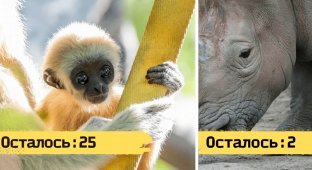Restoring faith in humanity: what species were saved from the brink of complete extinction? (16 photos)
It's no secret that the last century and a half has been bad for the biosphere. People have exterminated hundreds of species of plants and animals, and thousands of them are in a vulnerable position. Any careless action will wipe them off the face of the planet. And yet, I look to the future with cautious optimism: people have proven more than once that they are capable of preserving endangered species even against their own interests! 
Sometimes, in order to save a unique representative of the fauna, it is enough to simply leave it alone for a while. By 1967, the American alligator, for example, was included in the list of endangered species. In theory, this should have been done by the previous generation of American lawmakers. By the time they were included in the list, more than 90% of the alligator population had been used to make beautiful and durable leather goods. 
The average size of an American alligator is 3-3.6 meters. But sometimes monsters longer than 4 meters appear among them!
And you know what? Exactly 20 years later, they were removed from this list. At first, with a pencil, leaving the ban on hunting. But already in the 90s, hunters began to be issued licenses to shoot reptiles. And today the total number of American alligators has exceeded 5 million individuals and continues to grow! 
The US government even had to create special services that remove alligators from private property and shoot the most aggressive of them.
During the time when alligator hunting was banned, the popularity of crocodile skin declined, and the number of farms breeding alligators in captivity increased, they almost completely covered the demand. And the reptiles themselves did not waste time: adult specimens have no natural enemies, have enormous ecological plasticity and eat everything that smells like meat. They began to reproduce at a rapid pace. 
The beach is only for alligators, I do not recommend swimming here.
But we had to work much more thoroughly to save the sea otters. These animals are the largest representatives of the mustelid family, they can weigh up to 40 kilograms! Sea otters live on the coasts of the northern part of the Pacific Ocean. In order not to die, the animals have grown warm and waterproof skins. Which, in turn, attracted the interest of fur producers from both the British and Japanese Shogunate empires. 
And how could they raise their hands to destroy this cutie?
So the big hunt began. The domestic demand of each country was huge, and competition for a limited resource spurred them to kill even more. Within a century of the start of the hunt, the sea otters' range had halved. And by 1911, from a population of several hundred thousand individuals, barely 2 thousand animals remained, finding shelter on the rocky Medny Island. 
Even in our time, the island is completely uninhabited. Although until 2001, a border outpost operated here.
In the same year, all three parties (the British had been replaced by the United States by that time) realized that this could not continue, and that extinction was the only option. Thus, an international agreement was reached to ban sea otter hunting. Due to the complicated relations between the countries and the political nightmare of the first half of the 20th century, a complete ban on trade and protective measures were put into effect only by 1946. 
We will definitely survive!
But the result is obvious: now the number of sea otters has approached a hundred thousand individuals, and they have again populated 2/3 of the historical range. Further increase in the species population, however, is impossible. The state of the environment does not allow it. 
Who has such cute cheeks? That's right, me!
But that's just the tip of the iceberg. Butterflies began when people decided to save humpback whales from impending death. In general terms, the story turned out to be very similar to the story of sea otters. Whales were killed on an industrial scale a long time ago. In a few centuries, their numbers fell to only 5 thousand individuals. But in the 16th century there were about 160 thousand! 
In the 20th century alone, people killed more than 200,000 whales.
And the difficulties in creating an international treaty were the same as in the case of sea otters. Only on a larger scale. The range of humpback whales is the entire World Ocean, with the exception of the Mediterranean and some other seas. Therefore, almost every country with access to the sea had at least a theoretical opportunity to engage in whaling. In order to stop the destruction, EVERY economically developed country had to sign an agreement banning the hunting of humpback whales. 
Bro, can you take me to the North Pole? I'll pay you with fish!
In 1946, the International Whaling Commission was founded. It took her 20 years to create an agreement that would be accepted by most countries. This work was not in vain. Thanks to the coordinated actions of all countries and the exchange of scientific knowledge, the number of whales was increased to 135 thousand individuals! Their population has almost completely recovered! Now the state of humpback whales as a species does not cause concern. Hunting is allowed only for peoples for whom whaling is an integral part of their culture. 
But there is a nuance: aboriginal whaling must be carried out using traditional technologies, which greatly reduces its effectiveness.
But this does not mean that people should relax their buns and start mass exterminating recently saved mammals. Even the most numerous and resilient species cannot withstand targeted and unregulated hunting. What can we say if even wolves could not cope with this. 
Who is this cool smiling dog? Not him. It is a wolf.
Of course, the entire species was never under threat, after all, it inhabited most of the Northern Hemisphere. But in some regions it was almost completely exterminated! In the 20th century, less than a thousand wolves remained in Europe. Now, thanks to the strictest control and animal protection programs, their numbers have been raised to 17 thousand individuals. 
A wolf pack can number up to 20 individuals. But such large gangs are found only in regions with a high gray population.
And in the USA, the situation is even worse. Their population is about 18 thousand. It seems that this is quite a lot. But 2/3 of the population lives in Alaska. In all the other 49 states, today there are only 6 thousand wolves. And this, by the way, is a good result! 
A victory song in honor of the restoration of numbers.
The persecution of wolves in the United States lasted for several centuries. People have always shared territories with gray predators, but in the 19th century the confrontation reached its apogee: between 1870 and 1877, hunters killed about 100,000 wolves annually. Those crumbs of the population that remained after the genocide were finally finished off at the beginning of the 20th century. Only wolves from Alaska, far from people and civilization, managed to escape. 
In the 19th century, people hunted not only for protection, but also for fun. For example, bison were also exterminated en masse in America.
The Americans came to their senses only in the 1970s. The gray wolf, so familiar to us, became an endangered species in the United States. The situation was so dire that it was easier for the authorities to import wolves from Canada than to create conditions for the natural restoration of their numbers. However, now everything is returning to normal. In 2020, wolves were removed from the list of endangered species in three northern states. Predators are reappearing in American forests and are once again taking on the role of forest orderlies. 
All modern wolf protection programs are based on the experience of Yellowstone Park in the USA. Several packs of wolves brought from Canada immediately solved all the ecological problems of the park, as they became a force regulating the number of herbivores.























